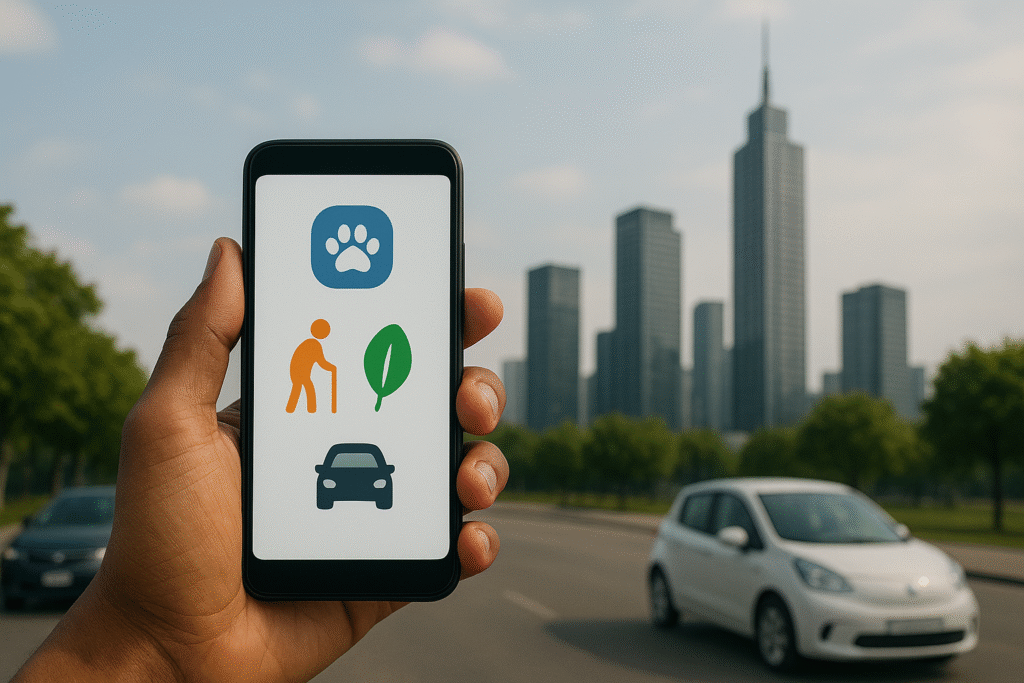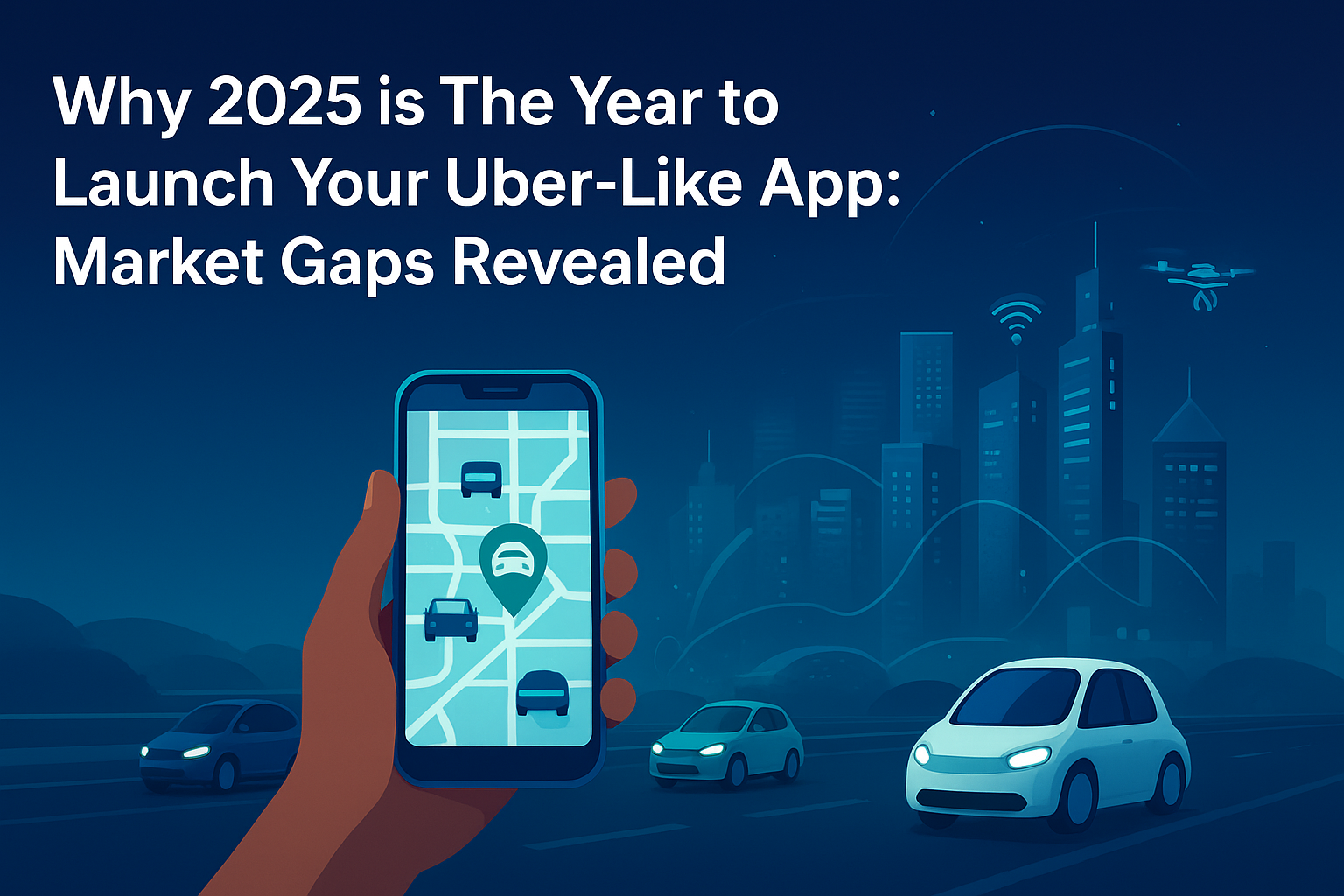As the time evolves we move deeper into the digital economy. 2025 is emerging as a pivotal year for entrepreneurs and startups. Especially for the ones looking to capitalize on the on-demand economy. We all are aware of the fact that Uber revolutionized transportation in the early 2010s. They set a new standard for convenience and accessibility.
Since then, countless ride-hailing and delivery apps have followed in its wake. But even after a decade of rapid innovation and growth, significant market gaps remain. In fact, 2025 presents a unique combination of technological readiness catering to shifting consumer expectations, and evolving regulatory landscapes that makes it the perfect time to launch your Uber-like app. Here’s why.
The Second Wave of On-Demand Services Is Here
- lack of regional coverage
- impersonal service
- one-size-fits-all models

Reasons Why It is High Time
The reason why now is the time and why the second wave of on demand economy is now are mentioned below
Post-Pandemic Behavior Has Permanently Changed
COVID-19 altered how people consider the normals like mobility. Not just that even health, and convenience. Post pandemic, there’s been a tremendous surge in demand for contactless. Everyone seeks efficient and tailored services. Remote work has transformed commuting patterns and the necessity for flexible and non-traditional transit solutions has drastically expanded.
Moreover, individuals are more accustomed to using digital platforms for everything. Even and especially grocery delivery and home cleaning. Users anticipate smooth, app-based interactions in nearly every area of life by 2025. The bar for entrance is greater, but so is the payoff for businesses who cater to all these factors and allow frictionless customer experiences.
Technological Maturity and Accessibility
The infrastructure required to build an Uber-like app is no longer the preserve of tech giants and with ClonifyNow’s uber clone app development, the process has never been more accessible. ClonifyNow provides ready-to-deploy solutions that include all the core features you need to compete in today’s on-demand economy: geolocation, real-time tracking, secure payment gateways, AI-powered customer support, and more.
Instead of piecing together APIs, SaaS platforms, and low-code tools on your own, ClonifyNow offers an end-to-end development ecosystem. This drastically reduces time-to-market and development costs. With 5G connectivity and edge computing advancements powering the apps, ClonifyNow ensures smooth, fast, and scalable performance even for startups with lean technical teams.
Consumer Trust Is Rebalancing
One of the unintended consequences of Big Tech dominance has been the erosion of consumer trust. There are data privacy breaches. If you build an app like uber you can ensure to prevent exploitative gig economy practices. You also get to replace impersonal service models that have left users craving alternatives. There’s a growing appetite for platforms that prioritize transparency. People care for fairness, and community values.
Gaps in Global and Regional Markets
Uber and its competitors are well-known in many big cities. However, many smaller cities and rural areas still don’t have enough services or are completely ignored. These areas often have specific transportation and service needs that the current players don’t meet. This is why an uber app clone is the ideal solution for new founders who intend to launch solutions that are tailored to their needs
In emerging markets, infrastructure problems and local regulations have slowed the growth of global giants. This gives regionally focused startups the chance to create solutions that fit with local customs, languages, and consumer behavior. 2025 is the best time to strike, as smartphone use and internet access are reaching critical mass around the world.
Regulatory Clarity Is Improving
In the past, regulatory uncertainty around ride-hailing and gig work often stymied innovation. Governments struggled to keep pace with technological change. This resulted in gray areas that discouraged new entrants. However, by 2025, many regions have established clearer legal frameworks.
This regulatory maturation means startups can now launch with a better understanding of their obligations and opportunities. Forward-thinking cities and municipalities are even offering grants and incentives for sustainable mobility and smart city solutions. This makes it more financially viable to enter the market.
Ecosystems for Innovation Are Expanding
Startup ecosystems around the world are maturing. There are accelerator programs and venture capitals. Even public-private partnerships are increasingly focused on mobility. Incubators are specifically targeting Uber-like platforms that offer innovative twists on traditional models.
Additionally, the gig economy workforce is more skilled and tech-savvy than ever before. This makes it easier to recruit and retain drivers. Not only drivers, couriers, and other service providers as well . If you can offer a better app experience and fair compensation, you can build a loyal network of workers who become ambassadors for your platform. Clonifynow’s uber clone script enables you to save out on development and provide a firmly fair environment for workforce
Investment Momentum and Capital Availability
In 2025, there will be a large appetite for new ideas in this space, particularly for startups that show both profitability and positive social impact. Crowdfunding platforms and alternative financing models are also allowing smaller players to enter the market without solely relying on traditional VC funding. This democratization of capital means that fearless founders with creative, community-driven visions have more avenues than ever before to raise the resources needed to launch.
Venture capital funding is increasingly flowing toward mobility and logistics innovation. Previously, investors poured billions into ride-hailing, but now they are looking for the “next Uber,” but not in the form of another generic competitor.
The Window of Opportunity Won’t Last Forever
This window of opportunity won’t stay open forever, even though 2025 is a good year for it. As customers’ expectations become more specific, bigger companies will have to fill in the gaps by buying other companies, forming alliances, or adding new features. Those who move first will build the loyalty and market presence they need to stay in business when bigger competitors come along later.
The right time is everything. If you launch too late, you may have to compete with established niche leaders who got early adopters. Entrepreneurs that act now will be the first to enter new verticals and will also benefit from the stability of a mature tech and regulatory ecosystem.
2025 Is the Year to Act
2025 is a once-in-a-decade chance for entrepreneurs because consumer expectations are changing. The technology is maturing, regulations are becoming clearer, and there are still untapped market gaps.
The playbook written by Uber and its competitors has shown that on-demand platforms can work. However, the future belongs to those who come up with new ideas that go beyond one-size-fits-all solutions.
If you’re thinking about launching your own Uber-like app, now is the time. You ought to keep your focus on hyper-local, and niche-specific solutions that appeal to modern consumers. To get the process started contact clonifynow now.

FAQS
1. How long does it take to develop an Uber-like app in 2025?
With modern tools and pre-built solutions like ClonifyNow, an Uber-like app can be launched in weeks instead of months. The exact timeline depends on customization and scalability needs.
2. What are the must-have features in an Uber-like app?
An Uber-like app should include real-time GPS tracking, secure digital payments, push notifications, AI-powered customer support, driver and user verification, and ratings & reviews. In 2025, eco-friendly options and seamless integrations are becoming increasingly important.
3. Can I build an Uber-like app for a niche market?
Yes! The biggest opportunities in 2025 are in hyper-local and niche services — such as pet transport, senior rides, women-only ride services, and eco-conscious deliveries. ClonifyNow helps entrepreneurs tailor apps for these specialized markets.
4. How does ClonifyNow ensure app reliability and performance?
ClonifyNow leverages the latest technologies like 5G, edge computing, and scalable cloud infrastructure to guarantee fast, secure, and responsive app experiences — even during peak demand.
5. Do I need technical expertise to launch an Uber-like app?
No. ClonifyNow provides end-to-end uber clone app development . We also take care of deployment, and provide ongoing support. This means founders can focus on growth and operations while ClonifyNow handles the technical heavy lifting.








 +91-9464826889
+91-9464826889